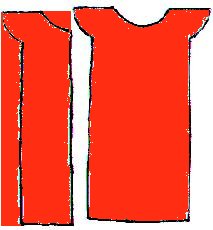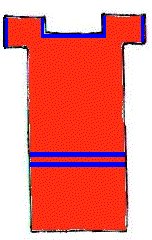Alternate neckline and sleeve shape:

Or, using a narrower piece of
fabric, leave the garment sleeveless (very popular). Or attach sleeves
made from another pattern. Some popular sleeve types were: long and close-fitted,
with or without a turned back cuff, long bell sleeves, or long and full
and gathered into a cuff (this type was often made of sheer fabric), or
short and straight, often with a turned back cuff. Some dresses, especially
in the early '20s, had three-quarter or elbow-length sleeves with turned
back cuffs, as was common in 1910s, but it seems that in most of the pictures
I've seen, this length is usually on conservative-looking dresses, often
being worn by older women.Turned back cuffs were sometimes of a contrasting
color, often white, especially if the dress was of a print fabric.

(Optional): Decorate with ribbon
or bias tape. Or add a sash or belt. Just remember that anything that delineates
the waistline should be below the natural waist. Make the dress sleeveless,
decorate with layers of fringe, and wear with a long string of beads, wrapped
around the neck two or three times or knotted, for the archetypical "flapper"
look.
BASIC
INSTRUCTIONS




